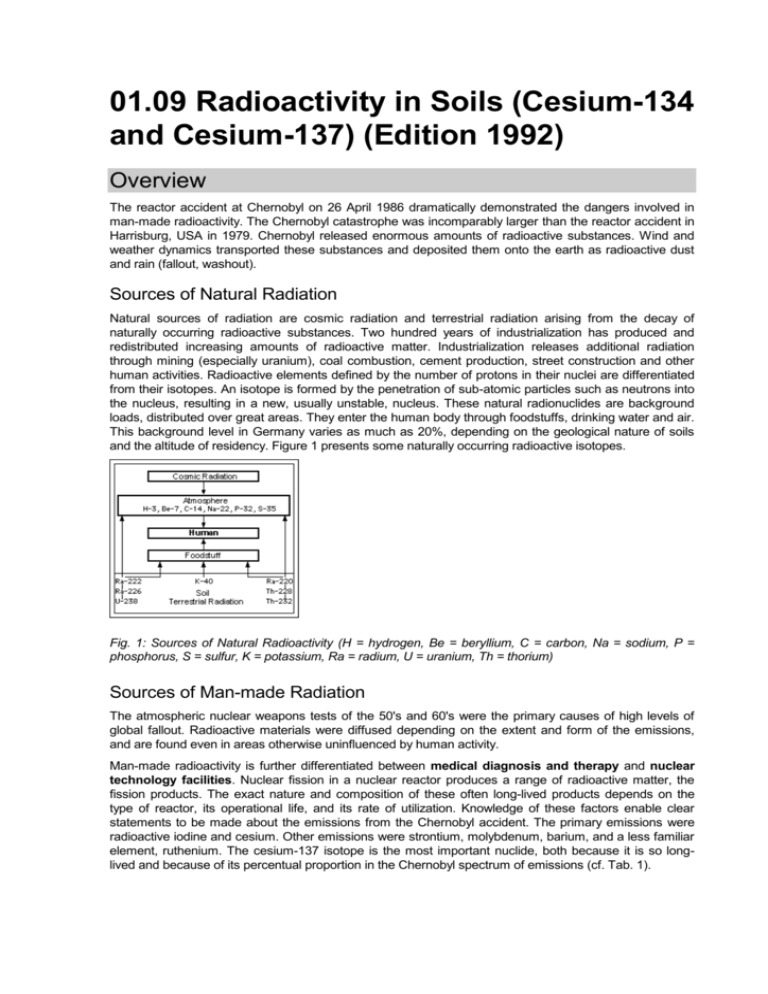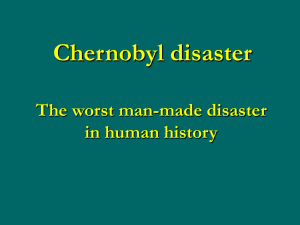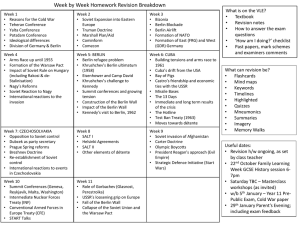01.09 Radioactivity in Soils (Cesium-134 and Cesium
advertisement

01.09 Radioactivity in Soils (Cesium-134 and Cesium-137) (Edition 1992) Overview The reactor accident at Chernobyl on 26 April 1986 dramatically demonstrated the dangers involved in man-made radioactivity. The Chernobyl catastrophe was incomparably larger than the reactor accident in Harrisburg, USA in 1979. Chernobyl released enormous amounts of radioactive substances. Wind and weather dynamics transported these substances and deposited them onto the earth as radioactive dust and rain (fallout, washout). Sources of Natural Radiation Natural sources of radiation are cosmic radiation and terrestrial radiation arising from the decay of naturally occurring radioactive substances. Two hundred years of industrialization has produced and redistributed increasing amounts of radioactive matter. Industrialization releases additional radiation through mining (especially uranium), coal combustion, cement production, street construction and other human activities. Radioactive elements defined by the number of protons in their nuclei are differentiated from their isotopes. An isotope is formed by the penetration of sub-atomic particles such as neutrons into the nucleus, resulting in a new, usually unstable, nucleus. These natural radionuclides are background loads, distributed over great areas. They enter the human body through foodstuffs, drinking water and air. This background level in Germany varies as much as 20%, depending on the geological nature of soils and the altitude of residency. Figure 1 presents some naturally occurring radioactive isotopes. Fig. 1: Sources of Natural Radioactivity (H = hydrogen, Be = beryllium, C = carbon, Na = sodium, P = phosphorus, S = sulfur, K = potassium, Ra = radium, U = uranium, Th = thorium) Sources of Man-made Radiation The atmospheric nuclear weapons tests of the 50's and 60's were the primary causes of high levels of global fallout. Radioactive materials were diffused depending on the extent and form of the emissions, and are found even in areas otherwise uninfluenced by human activity. Man-made radioactivity is further differentiated between medical diagnosis and therapy and nuclear technology facilities. Nuclear fission in a nuclear reactor produces a range of radioactive matter, the fission products. The exact nature and composition of these often long-lived products depends on the type of reactor, its operational life, and its rate of utilization. Knowledge of these factors enable clear statements to be made about the emissions from the Chernobyl accident. The primary emissions were radioactive iodine and cesium. Other emissions were strontium, molybdenum, barium, and a less familiar element, ruthenium. The cesium-137 isotope is the most important nuclide, both because it is so longlived and because of its percentual proportion in the Chernobyl spectrum of emissions (cf. Tab. 1). Effects The effects on health caused by ionizing radiation are of particular interest. These complex interrelations are still not completely clear today. In simplified form, the interrelations can be described as follows: radioactive decay transforms instable nuclides into stable isotopes by either emitting particles (electrons, positrons, neutrons) and/or electromagnetic radiation (photons). The energy of radiation is of great importance for dangers to health. After the emission of particles, new nuclides are often formed, which can also decay. The activity of a radioactive substance is measured in Becquerel (Bq) units. It expresses the number of nuclear disintegrations per second. 1 Bq signifies one disintegration per second. Half-life is the time required for the decay process to reduce activity by one-half. Half-life thus quantifies the time-period of higher activity and accumulation of that element in the environment. Activity is not the only physical factor that must be known in order to judge the effects of ionizing radiation (load charge transmission) on the human body. The fundamental danger of ionizing radiation is that changes in the cells can cause cancer or genetic damage. In order to judge these dangers in individual cases, other physical qualities must be taken into consideration. The effective equivalent dose, measured in Sievert (Sv), has a special significance. The Sievert attempts, by means of conversion factors, to quantitatively express the different biological effects of different kinds of radiation on individual organs of the human body - and in respect to their differing susceptibility to radiation. This is used as a basis in radiation protection regulations for determining limit values, assuming the average foodstuff consumption habits of a healthy adult. The determination of limit values also differentiates between persons exposed to radiation in their professions, and the general population. Development of Contamination by Man-made Radioactivity Investigations have deepened knowledge of the global spread and distribution of radionuclides in various areas of the biosphere ever since nuclear weapons tests began releasing man-made radionuclides into the atmosphere. A measurement series to determine average radioactive contamination in the air in Berlin was conducted for many years. Average man-made radiation values amount to less than 10% of natural levels (5-7 Bq/m3) even in periods of high contamination. Peak values for individual days, such as those reached after the reactor accident in Chernobyl, however, can be considerably above these values (cf. Fig. 4). Figure 2 shows a clear link between airborne contamination and atmospheric nuclear tests. Values in Berlin are to be interpreted as delayed effects, appearing in Berlin about one year after the nuclear tests. The length of time nuclides remained in higher levels of the atmosphere is an important factor. There were particularly high contamination levels 1963, caused by the nuclear weapon tests of 1961/62, when high-yield hydrogen bombs were detonated in the atmosphere. Fig. 2: Average Daily Rates of Man-made Radioactivity in the Air at Dahlem Measuring Station (remaining Beta activity) (FU Berlin 1992) Radioactivity measured in the 70's was due to tests by China and France, carried out in spite of the test ban. There was a drop-off to a very low level in the 80's. The level of man-made radiation in 1963 was a thousand times greater than from 1982 to 1985. Contamination values were driven up again only with the Chernobyl incident in 1986. Within a few days, a single event caused contamination levels over a large portion of Europe that are comparable only to the effects of the nuclear tests of 1961/62. Washout by rain and settling (sedimentation) led to a reduction of airborne contamination to "pre-Chernobyl-levels" by 1986. Course of the Chernobyl Reactor Incident At Chernobyl on 26 April 1986 at 1:23 a.m. local time, a sudden loss of performance occurred in one reactor core of a block. A fire in the reactor and the ensuing high temperatures carried released nuclides to an altitude of 1,500 m. The altitude of emissions, wind direction and speed resulted in the airborne transport and deposition of radioactive materials over several thousand kilometers, including the Berlin area. Emission was finally stopped on 13 May 1986. The airborne radioactivity reached Berlin on 30 April 1986 and produced the first outstanding peak level of contamination. Fig. 3: Diffusion of Emissions on 29 April 1986 at an Altitude of 1,500 m. Lines Marked in the Shaded Area Indicate Intervals of 12 Hours (Neider 1986) Figure 3 shows the diffusion of particles emitted on 29 April. The first two days of prevailing east winds carried emissions into Hungary and Austria. On 2 May the direction changed and south winds transported contaminants over large portions of southern Germany. Radionuclides in this air mass reached Berlin on 4 May and produced a second peak level in measurements of the air (cf. Fig. 4). Fig. 4: Daily Maximum Values of Total Beta Activity (natural and man-made radioactivity) in the Air in Berlin from 27 April to 12 May 1986. Measured at the Hahn-Meitner Institute (Neider 1986) The release and deposit of radioactive substances from the burning reactor initially endangered the population through inhalation of contaminated air. But the long-term processes - such as through deposition, are also significant. They are to be interpreted in relation to the environmental media of soil, ground and surface water, and foodstuffs. Soil is a special factor because it is the most important medium of departure for all storage transfer processes. Statistical Base Measuring Points A basis for work was provided by a body of data available from the Radiation Measuring Office of the Berlin Department of Urban Development and Environmental Protection. Measurements were made at 218 measuring points in the city and its near surroundings from 1989 to 1991. Samples were taken by soil bore cylinders from soils as undisturbed as possible, from the surface to a depth of 12 cm. Two horizons were differentiated; 0-6 cm and 6-12 cm. The selection of these horizons was based on the knowledge that most cesium-137 nuclides, representative of the nuclear tests of the 60's, were not yet stored in deeper soil layers. Measurements documented that cesium-137 originating from nuclear testing reached only a penetration depth of 1.7 to 4.7 cm, even in sandy soils, with a transport rate of 0.1 to 0.3 cm/yr. (Gans/Arndt 1987). Soils repeatedly processed and thus possessing a relatively constant storage depth, such as agricultural fields, were only of secondary significance in Berlin urban areas (cf. Fig. 5). A decomposition of isotopes by soil organisms can also be ruled out. Fig. 5: Depths of Activity Concentrations of Cesium(Cs)-134 and Cesium(Cs)-137 in Forest, Meadow and Field Soils (Average values for Bavaria, calculated to 1 June 1988) (Bavarian State Ministry for Land Development and Environmental Questions 1987) Parameter The analysis of the nuclides could be concentrated on a few isotopes for judging long-term soil contamination. The activity and thus the health-endangering effects of iodine-131, initially considered the most important isotope, is limited to a half-life of 8 days (cf. Tab. 1). It quickly became insignificant. Strontium-90, important for its great radiotoxicity, and plutonium isotopes were found only in very low traces in the atmosphere. They could be disregarded in relation to soil contamination. Clearly recognizable in this investigation of radionuclide composition conducted directly after the reactor incident, however, was that the two isotopes cesium-134 and particularly cesium-137 would contribute to radiation exposition well into the future. They were thus assigned an indicator function for the evaluation of contamination diffusion. The samples were analyzed for specific activity, measured in Bq/kg, and converted into area concentrations, expressed in Bq/m2. Questions of relevant entry mechanisms of radioactive isotopes into soils are of further interest. Basic soil science data were determined for pH, soil type, humus, etc. Meteorological data were also included in the investigations, including precipitation amounts and distributions from a total of 77 measuring stations. This was related to the main precipitation events following the Chernobyl incident (7-8 May 1986). Methodology The methodological starting-point was the knowledge that the isotopes cesium-134 and cesium-137, to be viewed as the key isotopes, were emitted from the reactor core in a precise ratio of 1:2. It was thus possible to separate the "Chernobyl-related" cesium-137 from the global fallout of the early nuclear tests. The cesium-134 from this time was no longer measurable in 1986. An expert opinion (Kannenberg 1991) spatially interpolated the activity concentrations of cesium-134 and cesium-137 at each measuring point, and related them to the following time periods: cesium-137 before the reactor accident in Chernobyl (Map 01.09.1) deposition of cesium-134 and cesium-137 resulting from the reactor accident in Chernobyl (Map 01.09.2) cesium-134 and cesium-137 as of 1 May 1987 (Map 01.09.3) cesium-134 and cesium-137 as of 1 May 1991 (Map 01.09.4). Interpolation of Measuring Values The methodic instruments for spatial interpolation of single values were the semi-variogram analysis, and the Kriging process, both used in the Berlin Environmental Information System. The variogram describes the variance of measure values for all pairs of measuring points in relation to their distance from each other. It gives a basis of comparison for the similarity of measurement results between point pairs of equal distance (cf. Fig. 6). Corresponding variograms were determined for different directions in those cases where variance depended not only on the distance, but also on how point pairs were situated (anisotropy). In contrast to linear interpolation processes, for example, the Kriging interpolation takes the determined spatial variability into consideration and thus gives assessment values with minimal incorrect ratings. A further advantage of this process is that the minimization of incorrect ratings gives a measure for the certainty of the determined assessed values (cf. Fig. 7). Fig. 6: Total Variogram, Referring to the Square Root of Surface Activity of the Isotopes Cesium-134 and Cesium-137 in Soils on 1 May 1987 (Kannenberg 1991) Consideration of Precipitation Quantities Radioactivity in the soil was compared with the diffusion of precipitation quantities on 7 and 8 May (Schlaak 1989) in order to clarify the interactions which influenced the structure of the radionuclide contamination. Dry high-pressure weather conditions prevailed in the first 10 days after the reactor incident. Thunderstorm precipitation began in the night of 7 May. Rain levels in some localities reached more than 40 mm of precipitation (the long-term average for May at the Dahlem measuring point is 49 mm). This rain enabled a washout of activity from the atmosphere and entries into soils and surface waters. Fig. 7: Map of Incorrect Ratings in Bq/m2, Referring to Surface Activity of the Isotopes Cesium-134 and Cesium-137 in Soils on 1 May 1987 (Kannenberg 1991) A comparison of the isohyete (precipitation contours) map of amounts of rain from 7 and 8 May 1986, and the map of radioactivity shows that they coincide with each other very much, even when a portion of inputs previously entered soils by dry deposition. There are however, no measuring values available for the Berlin area in order to separate dry nuclide depositions as aerosol (fallout) from wet depositions with precipitation (washout). Figure 8 explains the influence of the precipitation previously mentioned. Fig. 8: Precipitation Amounts and Activity of Cesium(Cs)-137 in Rain Water at Soorstrasse Measuring Station on 7 and 8 May 1986 Map Description The appended maps describe the contamination of the radioactive isotopes cesium-134 and cesium-137 in topsoils in the depth of 0-12 cm. Different reference times are depicted. Fig. 9: Average Surface-related Values of Cesium-134 and Cesium-137 in Berlin Soils and their Chronological Change with Radioactive Decay Figure 9 gives an analysis of pre-contamination levels, input amounts, and drops of activity in soils due to radioactive decay. The spatial distribution is clear in individual maps. Long-term inputs refer only to cesium-137, caused by the global fallout from atmospheric nuclear tests in the 50's and 60's. Cesium134 emitted at that time has no relevance today because of its short half-live of 2.1 years. This "preChernobyl contamination" of soils in Berlin reaches an average activity, in relation to area, of about 1,600 Bq/m2, as depicted in Fig 9. Cesium-137 activity was tripled by the Chernobyl reactor incident, while new inputs of cesium-134 correspond to about 1,600 Bq/m2. The average total cesium activity directly after the reactor accident is thus about 6,100 Bqm2. The drop in soil contamination is more determined by the decay of cesium-134 than it is by any transferring process. Map 01.09.1 Cesium-137 before the Chernobyl Reactor Accident The calculated spatial distribution of cesium-137 in topsoil before the reactor incident at Chernobyl is given in Map 01.09.1. The average value of all calculated single values is about 1,300 Bq/m2. The distribution of values and amounts can be gathered from Figure 10. A comparison with the situation in Bavaria shows that the location of the area to be tested is also decisive, even in the case of fallout caused by atmospheric nuclear tests. Fig. 10: Value Distribution and Amounts of Depositions of Cesium-137 in Soils in Berlin and Bavaria before the Chernobyl Incident (according to Kannenberg 1991 and the Bavarian State Ministry for State Development and Environmental Questions 1987) Previous contamination in the greater Berlin area was mainly in the range of 300 to 2,500 Bq/m 2. Contamination in Bavarian soils was higher. Values in Bavaria were concentrated in the range of 1,200 to 5,000 Bq/m2; individual values were sometimes 10 times higher. Even in consideration of the sample depth of up to 30 cm, which collected activity not only in disturbed soils (tilled fields) but also in greater depth, the causes of disparities in pollution distribution and amounts are due primarily to factors effective in small areas, as well as meteorological conditions such as long-term precipitation frequency, amounts, and wind direction dispersal. An interpretation of the spatial distribution of pollution in Berlin shows concentration peaks in West Berlin due to long-term average prevailing west and southwest winds combined with dry and wet deposition. Forest locations are to be given particular attention for the highest concentrations of activity appear here, in the humus layer, which is only a few centimeters thick. A particularly strong binding of the isotope cesium-137 with soil components takes place in this humus layer. In urban areas, in contrast, differentiating influence factors for small areas must often be expected. They are related to the external influence path (emissions) and to the soil substrates as well. The small-area variance of radionuclides can be further clarified only by very complicated investigations. Map 01.09.2 Depositions of Cesium-134 and Cesium-137 Resulting from the Chernobyl Reactor Accident The input situation of emitted material during the reactor accident was basically determined by meteorological conditions existing from 26 April to 13 May 1986. The rain-free, high-pressure weather conditions which prevailed during the first 10-12 days led to deposition distribution primarily dependent on the filtering capacities of topsoil structures, as well as the moisture content of the atmosphere. Besides forest locations, areas particularly affected were those where high humidity prevailed all day, or where atmospheric water vapor condensed with cooling in the night. The formation of dew leads to increased soil inputs, similar to wet depositions. The first precipitation took place from 7 to 8 May. There were very different deposition rates, paralleling precipitation amounts. Additional depositions of the more relevant cesium-137 at single measuring points reached 860 to about 5,600 Bq/m2; new inputs of cesium-134 swung between 430 and 2,600 Bq/m2. A comparison with the situation in Bavaria, Figure 10, shows how decisive the location of the test area is for new inputs too (cf. Fig. 11). Fig. 11: Value Distribution and Amounts of Depositions of Cesium-137 in Soils in Berlin and Bavaria after the Chernobyl Incident (according to Kannenberg 1991 and the Bavarian State Ministry for State Development and Environmental Questions 1987) Map 01.09.3 Cesium-134 and Cesium-137 on 1 May 1987 Total contamination loads (old and new inputs), calculated for 1 May 1987, show cesium-134 to have an activity of only 75% of its original load levels, due to its rate of decay. Contaminated areas were defined by new inputs from the Chernobyl incident, and old deposits. Map 01.09.4 Cesium-134 and Cesium-137 on 1 May 1991 The progression of radioactive decay of tested isotopes produced the results of 1 May 1991. Surface activity of cesium-134 is only 20% of original load levels, while cesium-137 concentrations have declined only about 7.5% in comparison to new inputs. Evaluation of Potential Dangers of Soil Loads Radioactive substances deposited in soils can reach humans through: soil-plant transfer washout into ground water disturbed soils direct radiation. It is difficult to make a direct evaluation for the dangers posed to humans by soil loads, because the transfer of pollutants such as cesium-137 from topsoil into cultivated plants is determined by many factors; particularly the type of soil, the type and age of plants, the concentration of pollutants in the soil and ground water, and other parameters. Transfer factors are disputed (Litz/Tietz 1987). These factors are used for the estimation of threats arising from soil contamination loads and as measure for the soilplant transfer. A transfer factor is defined as the concentration of pollutants in the plant, divided by the concentration of pollutants in the soil. The transposition of individual transfer factors, always determined by selected conditions for the respective individual situation, is linked to the observance of these boundary conditions. New investigations show that the concentration of a pollutant in a plant is directly related to the concentration of the pollutant in the waters of the soil, but not to the concentrations in the soil itself (Schüttelkopf/Schmidt 1990). Despite these limiting statements, some statements can be made about possible health threats posed by existing soil contamination loads in Berlin. Dosage through direct soil radiation - based on cesium-137 - is negligible. Measuring techniques cannot document it and it disappears in the background radiation. The inhalation of radioactive cesium through dust can be evaluated by measurements of activity concentrations in the air. It amounts on the average to less than 0.00001 Bq/m 2 and is negligible, even in comparison to the mean natural levels (such as radon-226 and its resulting products). Foodstuffs are therefore the only significant factor. They are investigated at both the production and the trade level. The Radiation Measurement Office of the Berlin Department of Urban Development and Environmental Protection publishes measuring results every week in "Weekly Reports" and distributes them to various information media, consumer associations, etc. Certain products continue to be listed among the more highly contaminated foodstuffs. Those are mainly forest fruits, mushrooms and animals that live on undisturbed, humus-rich forest soils. Literature [1] Bayerisches Staatsministerium für Landesentwicklung und Umweltfragen und Bayerisches Staatsministerium für Ernährung, Landwirtschaft und Forsten (Hrsg.) 1987: Radioaktive Kontamination der Böden in Bayern. [2] Freie Universität Berlin, Institut für Meteorologie 1992: Tagesmittelwerte der künstlichen Radioaktivität am Meßpunkt Dahlem in mBq/m 3 (Beta-RestAktivität), not published. [3] Gans, I. 1986: Künstliche Radioaktivität in der Umwelt vor und nach dem Reaktorunfall, in: Sonderheft Tschernobyl, Forschung aktuell, Zeitschrift der TU Berlin, S.32-37. [4] Gans, I., Arndt, J. 1987: Die Verteilung der langlebigen Spaltprodukte Strontium 90 und Cäsium 137 des KernwaffenFallouts im Boden, in: WaBoLu-Hefte, 2, Institut für Wasser-, Boden- und Lufthygiene des Bundesgesundheitsamtes, Berlin. [5] Kannenberg, M. 1991: Interpolation von Messungen zur Belastung durch Radionuklide im Stadtgebiet von Berlin, Gutachten im Auftrag der Senatsverwaltung für Stadtentwicklung und Umweltschutz, Berlin. [6] Litz, N., Tietz, B. 1987: Das Verhalten von natürlichen und künstlichen Radionukliden im Boden als Teil von Ökosystemen, in: Schriftenreihe Landschaftsentwicklung und Umweltforschung der TU Berlin, Nr.46. [7] Neider, R. 1986: Die radiologischen Auswirkungen des Reaktorunglücks von Tschernobyl in der Bundesrepublik Deutschland, in: Sonderheft Tschernobyl, Forschung aktuell, Zeitschrift der TU Berlin, S.45-49. [8] Renger, M. et al. 1986: Ausbreitung und Akkumulation von Radionukliden in Böden, in: Sonderheft Tschernobyl, Forschung aktuell, Zeitschrift der TU Berlin, S.26-31. [9] Schüttelkopf, H., Schmidt, W. 1990: Boden-Pflanzentransfer von toxischen Spurenelementen, in: Umweltforschung / Umwelttechnik, Hrsg.: Kernforschungszentrum Karlsruhe GmbH. [10] Senatsverwaltung für Stadtentwicklung und Umweltschutz Berlin (Hrsg.) o.J.: Die Arbeit der Strahlenmeßstelle Berlin, Berlin. [11] Senatsverwaltung für Stadtentwicklung und Umweltschutz Berlin (Hrsg.) 1987: Auswirkungen des Reaktorunglücks in Tschernobyl auf Berlin, Berlin. [12] Skala, W. et al. 1989: Anwendung geowissenschaftlicher Verfahren zur Interpolation räumlich verteilter Meßwerte am Beispiel der Belastung des Bodens durch Radionuklide. Gutachten im Auftrag der Senatsverwaltung für Stadtentwicklung und Umweltschutz, Berlin. Laws [13] Strahlenschutzverordnung (StrlSchV) vom 3. November 1989, GVBl. S.1898-1951. Maps [14] Schlaak, P. 1989: Verteilung der Niederschlagshöhen in Berlin - Isohyetenkarte zum 7./8. Mai 1986, not published.







